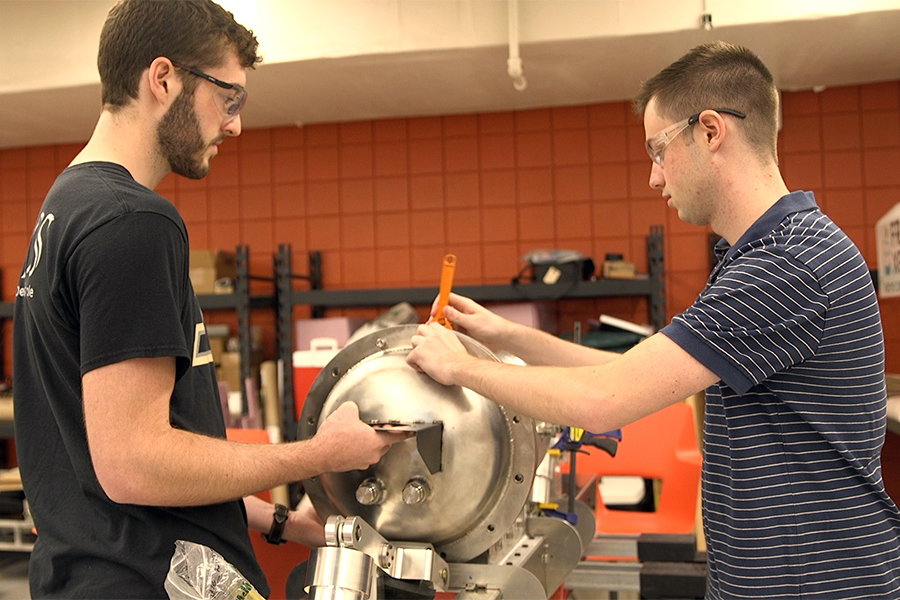Need for speed: Midwest Hyperloop ready to push pod at SpaceX competition

Ideally, Midwest Hyperloop will be watching its pod zipping down a mile-long tube, approaching 200 mph, on the final day of the 2019 Hyperloop Pod Competition.
To earn that coveted full-vacuum run at SpaceX’s headquarters July 21 in Hawthorne, California, though, the combined team that features students from Purdue, University of Illinois and University of Cincinnati will need to hit key quality checks and tests during the week.
Then, and only then, can the team get the ultimate thrill: Participating in a truly unique competition.
SpaceX founder Elon Musk initially published a white paper in 2013 on his big idea, a super-fast transportation system that moves capsules through a low-pressure tube. To help foster innovation and technology of the idea, Musk launched the first Hyperloop Pod Competition in January 2017. This July marks the fourth competition, the only one of its kind in the world.
“It’s basically a high-speed drag race, so it’s kind of insane in that respect, and unlike any other competition,” says Purdue’s team captain Sidd Subramanyam, a recent graduate of the School of Aeronautics and Astronautics who will start in its master’s program in the fall. “Teams have gone in excess of 200 mph, and every year they’re looking to break records.”
Midwest Hyperloop’s pod could travel upward of 190 mph, if all goes well.
And that kind of ultimate speed is exactly the point. The Hyperloop Pod Competition is judged solely on one criteria: Maximum speed with successful deceleration.
To accomplish that kind of speed, the three universities on Midwest Hyperloop divided responsibilities.
Purdue’s seven-member team — including three students from AAE — was responsible for software, electronics and sensors, suspensions and pneumatics systems. Its faculty advisor is Mark French, a professor at the Purdue Polytechnic Institute.
Illinois worked on the powertrain, including the high-voltage battery pack, battery managements systems, motor controller and motor testing. It also created the pressure vessel to house the batteries. Cincinnati handled the main chassis, pod shell and several other structural elements of the pod, including the transmission for the main propulsion wheel.
Because Purdue is geographically between Illinois and Cincy, it hosted members of both teams on campus to integrate the subsystems. All the components were shipped to L.A. on July 8.
Once they’re assembled for test week starting July 15, the team hopes to show off its 140 brake horsepower electric motor powering a chassis with only a curb weight of about 300 pounds.
“The power-to-weight ratio is pretty insane, higher than any car you’d see on the market today. We’re expecting accelerations of close to a G,” says Matthew Nichols, a senior-to-be in the School of Electrical and Computer Engineering. “We’re going to try to go fast.”
This is the fourth time a Purdue team has been selected for the competition. Logistical issues prevented the group from traveling to California last year, but that actually served to provide an extra year of work on the subsystems and the pod, allowing time to refine the design. It also could help this team be primed to race in tube at SpaceX.
During competition week, the team will need to pass a rigorous set of tests, including functional tests, navigation tests and vacuum chamber tests. Purdue has only qualified for a run through the hyperloop tube on the final day during its first competition, in January 2017. It was one of only six teams to do so. In August 2017, the second competition, only three teams had runs in the hyperloop tube on the final day, and Purdue wasn’t one of them.
It’s not a surprise, then, that the real focus for the upcoming competition is to refine the time it takes to qualify through the testing process and to get a functioning pod on the track.
“We’re really trying to nail the reliability aspect of the competition first,” says Subramanyam, who joined Purdue’s Hyperloop team in Fall 2016 and became team captain in Fall 2017, after the first of his two internships with SpaceX. “It’s a big process during competition week to try and get all the systems working and to pass all of the tests they first have us do. Only a handful of teams get through the process. We’ve been fortunate to be a team in the position in the past, but it still is an accomplishment, as this immediately puts us in the top six or seven (teams) in the world, if we just drive the pod in the vacuum tube.”
